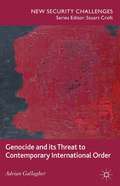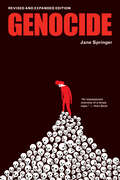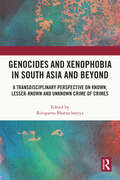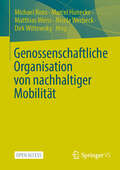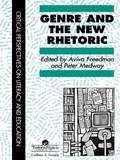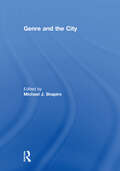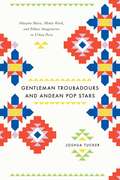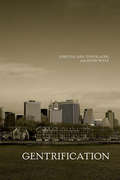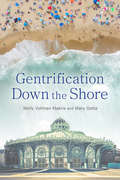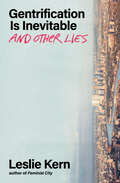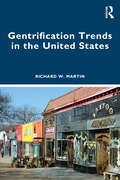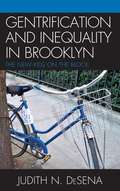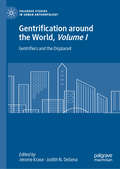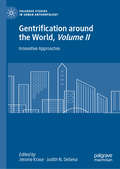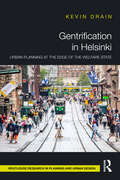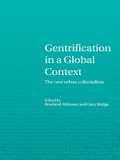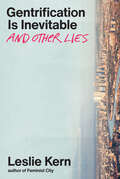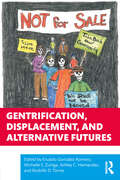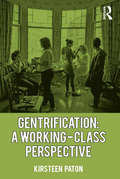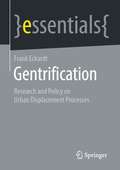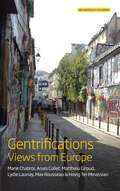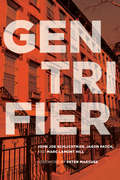- Table View
- List View
Genocide and its Threat to Contemporary International Order: Consent And The Controlled Body (New Security Challenges)
by A. GallagherFor far too long the discipline of International Relations has failed to engage with the study of genocide. This is despite the fact that genocide holds a direct relationship with the central concepts of international relations: the state, war, power, and security. This bold, innovative and unique book sets out to tackle this by bringing the concept of genocide into the discipline of IR, via the English School, in order to theorise the relationship between genocide, justice, and order. Drawing on a wide-range of primary and secondary interdisciplinary material from International Relations, Genocide Studies, Security Studies, International Law, History, Politics and Political Theory, this book aims to understand genocide within the context of International Relations and the implications that this has on policymaking. Gallagher identifies the obstacles and challenges involved in bringing the study of genocide into IR and uniquely analyses the impact of genocide on the ordering structure of international society.
Genocide: Key Themes
by A. Dirk Moses Donald BloxhamThe growth of scholarship on the pressing problem of genocide shows no sign of abating. This volume takes stock of Genocide Studies in all its multi-disciplinary diversity by adopting a thematic rather than case-study approach. Each chapter is by an expert in the field and comprises an up-to-date survey of emerging and established areas of enquiry while highlighting problems and making suggestions about avenues for future research. Each essay also has a select bibliography to facilitate further reading. <p><p>Key themes include imperial violence and military contexts for genocide, predicting, preventing, and prosecuting genocide, gender, ideology, the state, memory, transitional justice, and ecocide. The volume also scrutinizes the concept of genocide - its elasticity, limits, and problems. It does not provide a definition of genocide but rather encourages the reader to think critically about genocide as a conceptual and legal category concerned with identity-based violence against civilians.
Genocide: Revised and Expanded Edition (Groundwork Guides)
by Jane SpringerWhat is genocide? Why does it happen? What can be done to prevent it from happening again? At the end of the Second World War, with the establishment of the United Nations, the holding of the Nuremberg Trials and the adoption of the Genocide Convention, the international community assured itself that genocide would never happen again. But never again has become a meaningless phrase. This book asks why. It also asks, what is genocide? Where has it happened in the past? Who is being threatened by genocide today? And what can we do to prevent this terrible crime from recurring? Providing an overview of the history of genocide worldwide, this revised, expanded edition helps readers answer these questions. It brings them up to date with recent events—the killing of the Rohingya in Myanmar, the persecution of the Uyghurs in China, the broader recognition of the genocide of Indigenous Peoples, the resurgence of fighting in Darfur, and the wars in Ukraine and the Middle East. It examines and elucidates the debates and controversies surrounding the use of the term genocide as well as the reasons for the common response by individuals, governments and the United Nations — denial. Key Text Features annotated resources chapters definitions explanation facts further information further reading headings historical context illustrations index map sidebars table of contents timeline
Genocides and Xenophobia in South Asia and Beyond: A Transdisciplinary Perspective on Known, Lesser-known and Unknown Crime of Crimes
by Rituparna BhattacharyyaThis volume foregrounds some of the unknown or lesser-known incidents of xenophobia and genocide from India, Bangladesh, Sri Lanka, South Africa, and Rwanda. It critically analyses the cultural and structural contexts triggering these various forms of genocides and xenophobia, and situates them within modern histories of violence and human tribulations. The book discusses various non-western case studies which include the communal violence incited by anti-CAA protests in Delhi; the expulsion and displacement of Kashmiri Pandits; xenophobic attitudes against illegal immigrants in Assam; genocide in Sylhet during the Liberation War of Bangladesh; the 1994 genocide in Rwanda; and incidences of human rights violations across the world. A comprehensive and transdisciplinary text, the book will be useful for students and researchers of human geography, sociology, political science, social work, anthropology, colonialism and postcolonialism, nationalism, imperialism, human rights, and history.
Genossenschaftliche Organisation von nachhaltiger Mobilität
by Marcel Hunecke Michael Roos Matthias Weiss Nicola Werbeck Dirk WittowskyGenossenschaftliche Organisation von Mobilität ist eine soziale Innovation und ein vielversprechender Ansatz für eine effiziente Mobilität der Zukunft. Genossenschaften spielen in der Nachhaltigkeitstransformation eine wichtige Rolle. Das Open Access Buch ist die erste umfassende Aufarbeitung für Mobilitätsgenossenschaften und stellt die Frage nach deren Potenzialen, Chancen und Herausforderungen. Die Beiträge beleuchten aus interdisziplinärer Perspektive verschiedene Aspekte (Organisations- und Geschäftsmodelle, Zahlungsbereitschaften, verkehrs- und raumwissenschaftliche Aspekte, psychologische Einflussfaktoren), beschreiben durchgeführte Realexperimente und werten deren Erkenntnisse aus. Ein Leitfaden bietet zudem eine Hilfestellung für die Gründung und den Betrieb einer Mobilitätsgenossenschaft. Der Band enthält Beiträge aus dem Forschungsprojekt „GenoMobil – Genossenschaften als Organisationsform für eine sozial-ökologische Transformation integrierter Mobilität&“. Seine Zielgruppe sind Mobilitätswissenschaftler:innen sowie Privatpersonen und Institutionen auf der Suche nach geeigneten Organisationsformen gemeinschaftlicher Mobilität.
Genre In The New Rhetoric (Critical Perspectives On Literacy And Education Ser.)
by Peter Medway Aviva FreedmanSince The Mid-1980s The Notion Of "Genre" Has Been Dramatically Redefined. This redefinition has prompted theorists and scholars alike to analyze the shaping power of language and culture, and the interplay between the individual and the social.; Recent work in genre studies has drawn upon ideas and developments from a wide range of intellectual disciplines including 20th-century rhetoric, literary theory, sociology and philosophy of science, critical discourse analysis, education and cultural studies. In this text, leading theorists reflect and capitalize on the growing interest in genre studies across these allied fields, and examine the powerful implications this reconception of genre has on both research and teaching.
Genre and the City: Politics, Philosophy And Genre (Interventions Ser.)
by Michael J. ShapiroThis book’s chapters analyze aspects of urban politics with a combination of critical thinking (influenced by Walter Benjamin, Jacques Ranciere, Henri Lefebvre, and Achille Mbembe, among others) and readings of artistic genres (film, literature, and architecture). The coverage of cities includes, Tokyo, Paris, New York, Nairobi, Boston, Berlin and Hong Kong.
Gentleman Troubadours and Andean Pop Stars: Huayno Music, Media Work, and Ethnic Imaginaries in Urban Peru
by Joshua TuckerExploring Peru's lively music industry and the studio producers, radio DJs, and program directors that drive it, Gentleman Troubadours and Andean Pop Stars is a fascinating account of the deliberate development of artistic taste. Focusing on popular huayno music and the ways it has been promoted to Peru's emerging middle class, Joshua Tucker tells a complex story of identity making and the marketing forces entangled with it, providing crucial insights into the dynamics among art, class, and ethnicity that reach far beyond the Andes. Tucker focuses on the music of Ayacucho, Peru, examining how media workers and intellectuals there transformed the city's huayno music into the country's most popular style. By marketing contemporary huayno against its traditional counterpart, these agents, Tucker argues, have paradoxically reinforced ethnic hierarchies at the same time that they have challenged them. Navigating between a burgeoning Andean bourgeoisie and a music industry eager to sell them symbols of newfound sophistication, Gentleman Troubadours and Andean Pop Stars is a deep account of the real people behind cultural change.
Gentlemen's Disagreement: Alfred Kinsey, Lewis Terman, and the Sexual Politics of Smart Men
by Peter HegartyWhat is the relationship between intelligence and sex? In recent decades, studies of the controversial histories of both intelligence testing and of human sexuality in the United States have been increasingly common--and hotly debated. But rarely have the intersections of these histories been examined. In Gentlemen's Disagreement, Peter Hegarty enters this historical debate by recalling the debate between Lewis Terman--the intellect who championed the testing of intelligence-- and pioneering sex researcher Alfred Kinsey, and shows how intelligence and sexuality have interacted in American psychology. Through a fluent discussion of intellectually gifted onanists, unhappily married men, queer geniuses, lonely frontiersmen, religious ascetics, and the two scholars themselves, Hegarty traces the origins of Terman's complaints about Kinsey's work to show how the intelligence testing movement was much more concerned with sexuality than we might remember. And, drawing on Foucault, Hegarty reconciles these legendary figures by showing how intelligence and sexuality in early American psychology and sexology were intertwined then and remain so to this day.
Gentrification
by Loretta Lees Tom Slater Elvin WylyThis first textbook on the topic of gentrification is written for upper-level undergraduates in geography, sociology, and planning. The gentrification of urban areas has accelerated across the globe to become a central engine of urban development, and it is a topic that has attracted a great deal of interest in both academia and the popular press. Gentrification presents major theoretical ideas and concepts with case studies, and summaries of the ideas in the book as well as offering ideas for future research.
Gentrification Down the Shore
by Mary Gatta Molly Vollman MakrisGentrification in cities in the United States is a hot topic, but this book contributes something new to the ongoing discussion by offering a rich case study of seasonal gentrification and its effects on long time residents. Asbury Park, New Jersey, an iconic beachfront city, was a dynamic resort community in the late 19th and early 20th century. As the century wore on Asbury Park became an illustration of some of the macro social and economic structural changes occurring in cities across the United States with its own beachfront twist. Yet in 2019 Asbury Park’s narrative has shifted again—named among the coolest small towns in America the city has multimillion-dollar beachfront condos attracting the attention of Hollywood stars and national media attention as a travel destination. Summer days in Asbury once again mean tourists strolling the boardwalk and dining by the Atlantic Ocean. But just across the railroad tracks from the seasonal crowds, many of Asbury’s long-time residents live below poverty and struggle for their share of this prosperity throughout all four seasons of the year. Molly Vollman Makris and Mary Gatta engage in a rich ethnographic investigation of Asbury Park to better understand the connection between jobs and seasonal gentrification and the experiences of long time residents in this beach-community city. They demonstrate how the racial inequality in the founding of Asbury Park is reverberating a century later. This book tells an important and nuanced tale of gentrification using an intersectional lens to examine the history of race relations, the too often overlooked history of the post-industrial city, the role of the LGBTQ population, barriers to employment and access to amenities, and the role of developers as the city rapidly changes. Makris and Gatta draw on in-depth interviews, focus groups, ethnographic observation as well as data analysis to tell the reader a story of life on the West Side of Asbury Park as the East Side prospers and to point to a potential path forward.
Gentrification Is Inevitable and Other Lies
by Leslie KernFrom the author of the best-selling Feminist City, this urbanite’s guide to gentrification knocks down the myths and exposes the forces behind the most urgent housing crisis of our time. Gentrification is no longer a phenomenon to be debated by geographers or downplayed by urban planners—it’s an experience lived and felt by working-class people everywhere. Leslie Kern travels to Toronto, Vancouver, New York, London, and Paris to look beyond the familiar and false stories we tell ourselves about class, money, and taste. What she brings back is an accessible, radical guide on the often-invisible forces that shape urban neighbourhoods: settler-colonialism, racism, sexism, ageism, ableism, and more. Gentrification is not inevitable if city lovers work together to turn the tide. Kern examines resistance strategies from around the world and calls for everyday actions that empower everyone, from displaced peoples to long-time settlers. We can mobilize, demand reparations, and rewrite the story from the ground up.
Gentrification Trends in the United States
by Richard W. MartinGentrification Trends in the United States is the first book to quantify the changes that take place when a neighborhood’s income level, educational attainment, or occupational makeup outpace the city as a whole – the much-debated yet poorly understood phenomenon of gentrification. Applying a novel method to four decades of U.S. Census data, this resource for students and scholars provides a quantitative basis for the nuanced demographic trends uncovered through ethnography and other forms of qualitative research. This analysis of a rich data source characterized by a broad regional and chronological scope provides new insight into larger questions about the nature and prevalence of gentrification across the United States. Has gentrification become more common over time? Which cities have experienced the most gentrification? Is gentrification widespread, or does it tend to be concentrated in a small number of cities? Has the nature of gentrification changed over time? Ideal reading for courses in real estate, urban planning, urban economics, sociology, geography, econometrics, and GIS, this pathbreaking addition to the urban studies literature will enrich the perspective of any scholar of U.S. cities.
Gentrification and Displacement: The Forced Relocation of Public Housing Tenants in Inner-Sydney (Springerbriefs In Sociology)
by Alan MorrisThis book examines the forced displacement of public housing residents in Sydney’s Millers Point and The Rocks communities. It considers the strategies deployed by the government to pressure tenants to move, and the social and personal impacts of the displacement on the residents themselves. Drawing on in-depth interviews with tenants alongside government and media communications, the Millers Point case study offers a penetrating and moving analysis of gentrification and displacement in one of Australia’s oldest and more unique working class and public housing neighbourhoods. Gentrification and Displacement advances work in urban studies by charting trends in urban renewal and displacement, furthering our understanding of public housing, gentrification and the effects of forced relocation on vulnerable urban communities.
Gentrification and Inequality in Brooklyn: The New Kids on the Block
by Judith DeSena<p>While most studies on gentrification focus almost exclusively on its causes and consequences through an examination of housing, class conflict, and the displacement of residents, this book analyzes the process of gentrification. <i>Gentrification and Inequality in Brooklyn</i> examines the ways in which the established working-class and lower-income residents of Greenpoint, Brooklyn remain socially segregated from the incoming gentrifiers, with both groups forming parallel cultures within the shared physical spaces of the community. <p>Desena broadens the typical analyses of gentrification to include the grass roots dynamics which create social class relations that lead to residential segregation created by social class relations. Drawing upon areas traditionally under represented in urban sociology, including families, women, children, and local institutions other than housing, this study explores the ways in which working-class residents, in the course of their everyday lives, negotiate change in their neighborhood and dissimilarity with their new (gentry) neighbors. <p><i>Gentrification and Inequality in Brooklyn</i> touches on issues familiar to anyone who has lived in a multi-class or multi-ethnic community, while offering new perspectives on the ways that such communities develop and maintain the boundaries of social segregation.</p>
Gentrification around the World, Volume I: Gentrifiers and the Displaced (Palgrave Studies in Urban Anthropology)
by Jerome Krase Judith N. DeSenaBringing together scholarly but readable essays on the process of gentrification, this two-volume collection addresses the broad question: In what ways does gentrification affect cities, neighborhoods, and the everyday experiences of ordinary people? In this first volume of Gentrification around the World, contributors from various academic disciplines provide individual case studies on gentrification and displacement from around the globe: chapters cover the United States of America, Spain, Brazil, Sweden, Japan, Korea, Morocco, Great Britain, Canada, France, Finland, Peru, India, Indonesia, Pakistan, Syria, and Iceland. The qualitative methodologies used in each chapter—which emphasize ethnographic, participatory, and visual approaches that interrogate the representation of gentrification in the arts, film, and other mass media—are themselves a unique and pioneering way of studying gentrification and its consequences worldwide.
Gentrification around the World, Volume II: Innovative Approaches (Palgrave Studies in Urban Anthropology)
by Jerome Krase Judith N. DeSenaBringing together scholarly but readable essays on the process of gentrification, this two-volume collection addresses the broad question: In what ways does gentrification affect cities, neighborhoods, and the everyday experiences of ordinary people? In this second volume of Gentrification around the World, contributors contemplate different ways of thinking about gentrification and displacement in the abstract and “on-the-ground.” Chapters examine, among other topics, social class, development, im/migration, housing, race relations, political economy, power dynamics, inequality, displacement, social segregation, homogenization, urban policy, planning, and design. The qualitative methodologies used in each chapter—which emphasize ethnographic, participatory, and visual approaches that interrogate the representation of gentrification in the arts, film, and other mass media—are themselves a unique and pioneering way of studying gentrification and its consequences worldwide.
Gentrification in Helsinki: Urban Planning at the Edge of the Welfare State (Routledge Research in Planning and Urban Design)
by Kevin DrainThis book unravels the paradox of gentrification in Helsinki, Finland. Here, housing and welfare policies work well under certain conditions to prevent the worst outcomes of residential gentrification. Yet other forms of gentrification have proliferated in recent years, and local urban planning has gained a momentum in efforts to remake the urban landscape for business and tourism.Through a range of methods, each chapter approaches a different aspect of gentrification: the effectiveness of welfare policies against residential gentrification, the importance of retail gentrification and symbolic changes, the role of media and state-led tourism campaigns in promoting gentrification, the rise of vibrancy and sustainability as concepts driving regeneration, and the question of planning principles like participation in confronting gentrification. The reader will find a state system that supports a delicate balance in housing, but a local planning regime related to a more “generalized” gentrification. The results raise questions about the limits of the welfare state in an age of global competition.While new readers of gentrification will benefit from a deep engagement with the literature, the case of Helsinki is relevant to all students of planning, social sciences, and urban studies, as well as professionals in related fields.
Gentrification in a Global Context: The New Urban Colonialism (Housing and Society Series)
by Gary Bridge Rowland AtkinsonGentrification, a process of class neighbourhood upgrading, is being identified in a broader range of urban contexts throughout the world. This book throws new light and evidence to bear on a subject that deeply divides commentators on its worth and social costs given its ability to physically improve areas but also to displace indigenous inhabitants.Gentrification in a Global Perspective brings together the most recent theoretical and empirical research on gentrification at a global scale. Each author gives an overview of gentrification in their country so that each chapter retains a unique approach but tackles a common theme within a shared framework. The main feature of the book is a critical and well-written set of chapters on a process that is currently undergoing a resurgence of interest and one that shows no sign of abating.
Gentrification is Inevitable and Other Lies
by Leslie KernHow Gentrification is killing our cities, and what we can do about itWhat does gentrification look like? Can we even agree that it is a process that replaces one community with another? It is a question of class? Or of economic opportunity? Who does it affect the most? Is there any way to combat it? Leslie Kern, author of the best selling Feminist City, travels from Toronto, New York, London, Paris and San Francisco and scrutinises the myth and lies that surround this most urgent urban crisis of our times.First observed in 1950s London, and theorised by leading thinkers such as Ruth Glass, Jane Jacobs and Sharon Zukin, this devastating process of displacement now can be found in every city and most neighbourhoods. Beyond the Yoga studio, farmer's market and tattoo parlour, gentrification is more than a metaphor, but impacts the most vulnerable communities. Kern proposes an intersectional way at looking at the crisis that seek to reveal the violence based on class, race, gender and sexuality. She argues that gentrification is not natural That it can not be understood in economics terms, or by class. That it is not a question of taste. That it can only be measured only by the physical displacement of certain people. Rather, she argues, it is an continuation of the setter colonial project that removed natives from their land. And it can be seen today is rising rents and evictions, transformed retail areas, increased policing and broken communities.But if gentrification is not inevitable, what can we do to stop the tide? In response, Kern proposes a genuinely decolonial, feminist, queer, anti-gentrification. One that demands the right to the city for everyone and the return of land and reparations for those who have been displaced.
Gentrification, Displacement, and Alternative Futures
by Erualdo González RomeroGentrification is one of the most debilitating—and least understood—issues in American cities today. Scholars and community activists adjoin in Gentrification, Displacement, and Alternative Futures to engage directly and critically with the issue of gentrification and to address its impacts on marginalized, materially exploited, and displaced communities. Authors in this collection begin to unpack and explore the forces that underlie these significant changes in an area’s social character and spatial landscape. Central in their analyses is an emphasis on racial formations and class relations, as they each look to find the essence of the urban condition through processes of demographic change, economic restructuring, and gentrification. Their original findings locate gentrification within a carefully integrated theoretical and political framework and challenge readers to look critically at the present and future of gentrification studies. Gentrification, Displacement, and Alternative Futures is a vital read for scholars and researchers, as well as planners and organizers hoping to understand the contemporary changes happening in our urban areas.
Gentrification: A Working-class Perspective
by Kirsteen PatonFocusing on the working-class experience of gentrification, this book re-examines the enduring relationship between class and the urban. Class is so clearly articulated in the urban, from the housing crisis to the London Riots to the evocation of housing estates as the emblem of ’Broken Britain’. Gentrification is often presented to a moral and market antidote to such urban ills: deeply institutionalised as regeneration and targeted at areas which have suffered from disinvestment or are defined by ’lack’. Gentrification is no longer a peripheral neighbourhood process: it is policy; it is widespread; it is everyday. Yet comparative to this depth and breadth, we know little about what it is like to live with gentrification at the everyday level. Sociological studies have focused on lifestyles of the middle classes and the working-class experience is either omitted or they are assumed to be victims. Hitherto, this is all that has been offered. This book engages with these issues and reconnects class and the urban through an ethnographically detailed analysis of a neighbourhood undergoing gentrification which historicises class formation, critiques policy processes and offers a new sociological insight into gentrification from the perspective of working-class residents. This ethnography of everyday working-class neighbourhood life in the UK serves to challenge denigrated depictions which are used to justify the use of gentrification-based restructuring. By exploring the relationship between urban processes and working-class communities via gentrification, it reveals the ’hidden rewards’ as well as the ’hidden injuries’ of class in post-industrial neighbourhoods. In doing so, it provides a comprehensive ’sociology of gentrification’, revealing not only how gentrification leads to the displacement of the working class in physical terms but how it is actively used within urban policy to culturally displace the working-class subject and traditional
Gentrification: Research and Policy on Urban Displacement Processes (essentials)
by Frank EckardtThis essential presents the state of urban research on gentrification in a condensed form. This term, which has been used in the scientific community since the 1960s, has now also become established in the public debate. It describes how rising rents in the cities and the lack of affordable housing lead to poorer residents being driven out of their neighbourhoods. It becomes clear in what way gentrification is a general principle of urban development and thus poses a considerable challenge to the social mix of our cities. It also shows what political measures should be taken from the perspective of research in order to prevent gentrification.This Springer essential is a translation of the original German 1st edition essentials, Gentrifizierung by Frank Eckardt, published by Springer Fachmedien Wiesbaden GmbH, part of Springer Nature in 2018. The translation was done with the help of artificial intelligence (machine translation by the service DeepL.com). A subsequent human revision was done primarily in terms of content, so that the book will read stylistically differently from a conventional translation. Springer Nature works continuously to further the development of tools for the production of books and on the related technologies to support the authors.
Gentrifications: Views from Europe (Anthropology of Europe #7)
by Lydie Launay Marie Chabrol Anaïs Collet Matthieu GiroudOffering an original discussion of the gentrification phenomenon in Europe, this book provides new theoretical insights into classical works on the subject. Using a thorough analysis of the diversity of the forms, places and actors of gentrification in an attempt to isolate its ‘DNA’, the book addresses the place of social groups in cities, their competition over the appropriation of space, the infrastructure unequally offered to them by economic and political actors and the stakes of everyday social relationships.
Gentrifier
by Peter Marcuse Marc Lamont Hill Jason Patch John Joe SchlichtmanAs urban job prospects change to reflect a more ‘creative’ economy and the desire for a particular form of ‘urban living’ continues to grow, so too does the migration of young people to cities. Gentrification and gentrifiers are often understood as ‘dirty’ words, ideas discussed at a veiled distance.Gentrifiers, in particular, are usually a ‘they.’ Gentrifier demystifies the idea of gentrification by opening a conversation that links the theoretical and the grassroots, spanning the literature of urban sociology, geography, planning, policy, and more. Along with established research, new analytical tools, and contemporary anecdotes, John Joe Schlichtman, Jason Patch, and Marc Lamont Hill place their personal experiences as urbanists, academics, parents, and spouses at the centre of analysis. They expose raw conversations usually reserved for the privacy of people’s intimate social networks in order to complicate our understanding of the individual decisions behind urban living and the displacement of low-income residents. The authors’ accounts of living in New York City, San Diego, Chicago, Philadelphia, and Providence link economic, political, and sociocultural factors to challenge the readers’ current understanding of gentrification and their own roles within their neighbourhoods. A foreword by Peter Marcuse opens the volume.
